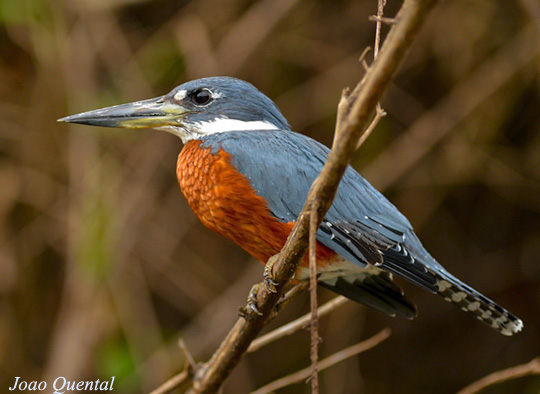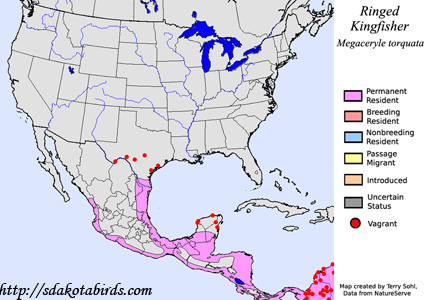| Length: 16 inches | Wingspan: 24-28 inches | Seasonality: Non-resident in South Dakota |
| ID Keys: Slate blue upperparts and head, with white neck ring; Male rusty below; Female slate blue on chest, white band below that, then rusty belly | ||
 The
Ringed Kingfisher is the largest kingfisher species in the Americas.
Its range covers South America, Central America, and Mexico, just extending
into the United States in far southern Texas. They appear to be expanding
their range northward into the Untied States. The first breeding
record in Texas didn't occur until 1970, but they have become increasingly
common since then.
The
Ringed Kingfisher is the largest kingfisher species in the Americas.
Its range covers South America, Central America, and Mexico, just extending
into the United States in far southern Texas. They appear to be expanding
their range northward into the Untied States. The first breeding
record in Texas didn't occur until 1970, but they have become increasingly
common since then.
Habitat: Found along rivers and streams, in any area suitable for foraging, and with sutiable river banks for building nest burrows. They tend to be found along rivers with a signfiicant amount of forestland surrounding it.
Diet: Feeds heavily on fish, but will also take small lizards, snakes, amphibians, and insects.
Behavior: Forages by observing from a prominent perch, plunging down to capture fish when sighted. They are also capable of hovering while looking down for prey.
Nesting: The nest of a Ringed Kingfisher is a burrow, typically along the bank of a river. The nest burrow can be as deep as 8 feet, and is lined with fish bones and scales. The female lays between 2 and 6 eggs. Both parents help to incubate the eggs, and both parents tend to the young once they hatch.
Song: Very noisy and conspicuous birds, with loud cla-ak calls. The song is a low-pitched, harsh rattling.
Migration: Considered a permanent resident throughout their normal range.
Interactive eBird map: Click here to access an interactive eBird map of Ringed Kingfisher sightings
Similar Species: Belted Kingfisher. The large size and much more extensive rusty area on the belly make it easily distinguished from that species if seen well.
Conservation Status: Populations appear to be stable and the species covers a very wide geographic range. The IUCN lists the Ringed Kingfisher as a species of "Least Concern".
Further Information: 1) Audubon Guide - Ringed Kinfisher
2) Texas Breeding Bird Atlas - Ringed Kingfisher
3) Whatbird - Ringed Kingfisher
Photo Information: Photo by Joao Quental- October 2nd, 2014 - Barao De Melgaco, Mato Grosso, Brazil - Photo licensed under Creative Commons Attribution 2.0 Generic license
| Click below for a higher-resolution map |
 |
| South Dakota Status: Non-resident in South Dakota |
Additional Ringed Kingfisher Photos (coming soon!!)
